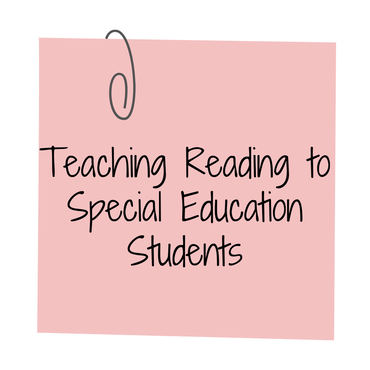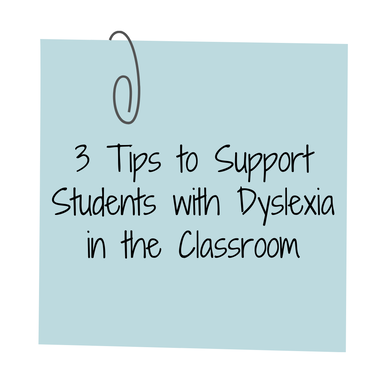Discover Miss Rae's Room Dyslexia Blogs, a comprehensive series dedicated to empowering educators and promoting effective strategies for students with Dyslexia. From different types of Dyslexia and Dyslexia screeners to signs of Dyslexia and evidence-based interventions and accommodations in the general education classroom, explore the infusion of the Science of Reading into instruction, explore school's roles in defining Dyslexia, and learn about best practices for teaching students with Dyslexia. Gain valuable insights and practical guidance to create inclusive and supportive learning environments. Start your journey towards improving outcomes for students with Dyslexia today!
|
10/9/2021 2 Comments Universal Dyslexia Screeners
Are there more students with dyslexia now than there were previously?
Dyslexia is the most common learning disability in the United States. Dyslexia impacts one in five students, or about 20% of our student population. Experts say that there are not more people with Dyslexia than in previous times; however, there are more students with Dyslexia being appropriately identified. The National Institute of Health has found dyslexia is identifiable from age 5.5 years with 92% accuracy. And The International Dyslexia Association recommends screening every student for Dyslexia. Stats and recommendations like those are partly why many states have introduced Dyslexia laws. These laws include the requirement of public school districts to administer Dyslexia screenings to all students. Currently, Dyslexia screenings are required in 43 U.S. states as of March 2019, according to the National Center on Improving Literacy. Other reasons for this change are due to our increased knowledge of learning disabilities and the science of reading instruction. But what are Dyslexia screeners?
What are Dyslexia screeners?
Dyslexia screeners are universal screeners used to identify students who exhibit the key characteristics of Dyslexia. They are administered by the school’s classroom teachers and/or reading teachers. These personnel would have been trained by either the screener or other professionals in the school who have been trained on administering the assessment. Dyslexia screeners should be part of the universal screening process for all students. What is the purpose of Dyslexia Screeners? Dyslexia screeners help schools to gather and respond to data on reading difficulties as early as possible in a student’s educational career. Schools screen for Dyslexia in order to provide appropriate instruction and targeted intervention for students who demonstrate reading difficulties. And we know - early intervention is key! Highly effective interventions can prevent and/or correct the majority of reading difficulties. Therefore, if we provide our students with a strong Tier One curriculum and intensive interventions for identified reading difficulties, all of our students should be able to learn to read! The earlier we can identify a student, the earlier we can intervene, and that means the less the long-term effects will be! This is because brain research tells us that brain plasticity decreases through childhood. So the later a student is identified for intervention, the harder it is going to be to instruct to proficiency.
It actually takes four times as long to intervene in fourth grade as it does in kindergarten. Experts say that this is not only because of brain development, but also due to the increase in content for students to learn in the later grades.
And even worse - struggling readers tend to experience psychological impacts from their struggles with reading. Such implications can be prevented and/or minimized if we identify and intervene as early as possible. And Dyslexia screeners are one way schools can do this! In order to determine if a student is Dyslexic, we need to measure student ability in specific areas of reading. Areas to be measured should include... -phonological awareness, -phonological or language-based memory, -rapid automatic naming, -receptive vocabulary, -phonics skills, -decoding/encoding real and pseudo-words, -oral reading fluency, and -writing at the sentence and paragraph level. Dyslexia screenings measure many of these areas. Research has shown that “Deficits in phonological awareness, rapid automatized naming, verbal working memory and letter knowledge have been shown to be robust precursors of dyslexia in children as young as age three” (Gaab, 2017). So screenings for Dyslexia should include timed tests of letter naming or letter-sound associations in kindergarten and early first grade. Students’ ability on phoneme awareness tasks in kindergarten and beginning first grade level should be included in the screening. Direct measures of decoding and word recognition toward the middle and end of first grade and beyond are important to build a profile of the student’s skills. Oral reading fluency measure, or a timed test that combines reading rate and accuracy, should be administered once the student can read connected text in a screening for Dyslexia (Moats and Dakin, 2008). Dyslexia is a neurobiological, or hereditary, meaning it runs in families. So questionnaires can be included to identify students who have Dyslexia in their family.
The strongest indicators of Dyslexia in kindergarteners are difficulties with phonemic awareness, learning letter-sound relationships, and learning to decode using phonemic decoding strategies by the end of 1st grade.
Once instruction in the general education classroom turns its focus to the phonological components of reading and identification of distinctions and differences in sounds in spoken words, students who are not making effective progress, should be quickly identified and provided with early intervention. If the problems continue to persist despite intensive intervention, Dyslexia can be considered. Enter - the Dyslexia evaluation… A Dyslexia evaluation is different from a Dyslexia screening! A Dyslexia evaluation is different from a Dyslexia screening!
Screenings are given to ALL students. Screenings allow us to monitor student progress and provide intervention instruction. Once identified as needing intervention, we should provide a highly effective intervention for the student. However, if a student shows little to no progress in response to an intensive intervention, the student should be referred for a comprehensive evaluation.
An evaluation for Dyslexia is administered to students who have demonstrated little to no progress in response to highly effective intervention instruction. An evaluation should be completed by a multi-disciplinary team. While the areas of assessment may be the same as what we screened, these evaluations should be much more extensive. Schools can perform such a comprehensive evaluation. The purpose of the school’s evaluation, though, is not to diagnose (because a school cannot diagnose Dyslexia), but rather, a school’s evaluation is administered for the purpose of determining eligibility for Special Education services. Schools can perform a comprehensive reading evaluation. They can identify a student as having a Specific Learning Disability in the area of Reading. But schools cannot provide a formal diagnosis for Dyslexia. A formal diagnosis can only be given by a professional in the field such as an educational psychologist. This, then, would be considered a Dyslexia evaluation. Schools cannot provide a formal diagnosis for Dyslexia.
You can learn more about Comprehensive Reading Evaluations by taking the course with ME at The Learning Tree PDN!
So let’s summarize...
Dyslexia screeners help us to identify students who need intervention in reading. If one of those identified students makes minimal to no progress in response to a highly, effective intervention, schools should refer the student for a comprehensive evaluation, used to determine if the student is eligible for Special Education services. If a diagnosis is required for a student to obtain the appropriate instruction, intervention, and educational plan, then you want a Dyslexia evaluation! Happy Teaching! Peace Miss Rae
References:
Gaab, N. (2017). "It's a Myth that Young Children Cannot Be Screened for Dyslexia!" International Dyslexia Association. Kilpatrick, D. A. (2015). Essentials of assessing, preventing, and overcoming reading difficulties. Moats, L. C., & Dakin, K. E. (2008). Basic facts about dyslexia and other reading problems. Baltimore, MD: The International Dyslexia Association. Related Blogs
2 Comments
|
Proudly powered by Weebly












 RSS Feed
RSS Feed